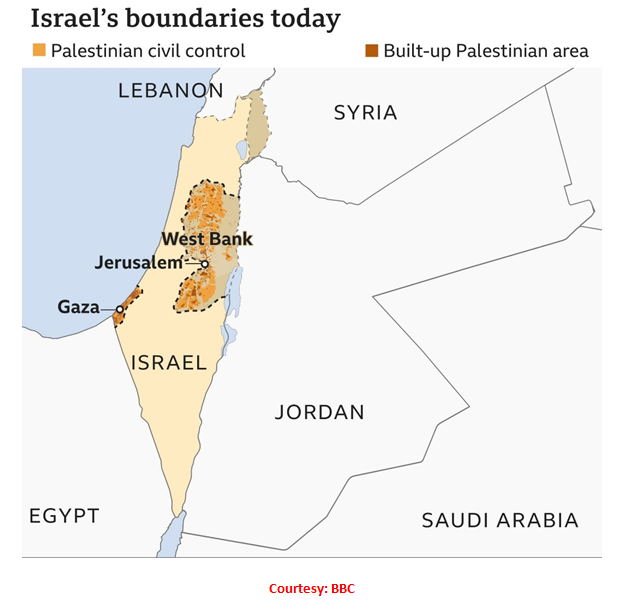

The violent clash between Israel and Hamas during May 10-21, 2021 has brought back the prolonged Israeli-Palestinian conflict to the forefront of complex issues afflicting West Asia.
Context
The violent clash between Israel and Hamas during May 10-21, 2021 has brought back the prolonged Israeli-Palestinian conflict to the forefront of complex issues afflicting West Asia.
Background
- The multiplicity of conflicts, tensions and rivalries in the region since 2011 had relegated the Israeli-Palestinian conflict to the bottom of regional issues.
- The significance of the conflict had further diminished under the four years of Donald Trump’s presidency, with his administration focused on isolating Iran through the “maximum pressure” campaign.
- The signing of the Abraham Accords between Israel and four Arab countries, namely the United Arab Emirates, Bahrain, Morocco and Sudan, in August 2020, did raise hopes for progress towards peace.
- However, the renewed escalation between Israel and Hamas diminishes any hopes for a peaceful resolution of the conflict in the immediate future.
- The beginning of the escalation can be traced to the protests in mid-April by 13 Palestinian families in Sheikh Jarrah, a locality in East Jerusalem, facing eviction from their homes after losing a court battle against Jewish settlers.
- It provoked counter-protests by extremist Jewish groups, sparking violence and rioting that soon spread to the Haram al-Sharif/Temple Mount area leading to clashes in the Al-Aqsa compound on May 7.
- In trying to control the situation, the Israeli police and IDF personnel entered the compound - managed by the Waqf Council under Jordanian tutelage, leading to hundreds of Palestinians and scores of IDF personnel getting injured.
- Hamas saw this as an opportunity to reiterate its position as the leading Palestinian resistance movement (underscoring its undying spirit to fight for the Palestinian rights and against the Israeli occupation) and issued an ultimatum to Israel to withdraw its security personnel from Al-Aqsa by 6:30 pm on May 10.
- As the deadline expired, Hamas launched a barrage of rockets indiscriminately targeting civilian establishments and residential buildings in southern Israel and at targets in Jerusalem and Tel Aviv.
- The IDF retaliated by launching a full-fledged military campaign, codenamed Operation Guardian of the Wall, on May 11.
- The escalation was accompanied by protests and rioting in the occupied West Bank and East Jerusalem as well as in the mixed Arab-Jewish towns in Israel, highlighting the growing sympathy for Hamas among the wider Palestinian community.
- After mounting international pressure, the ceasefire agreement was announced on May 21, 2021.
Analysis
There are six important lessons that the violence brings to the fore.
- Firstly, the Israeli-Palestinian conflict is not dead. The multiplicity of conflicts, tensions and rivalries in the region since 2011 had relegated the Israeli-Palestinian conflict to the bottom of regional issues. This had many believing that the prolonged conflict is no longer a serious issue. Such assumptions have been proved wrong by the current spate of violence.
- Secondly, the hopes for the revival of the peace process, that had been raised in the wake of the signing of the Abraham Accords, have diminished.
- Thirdly, the clashes have underlined the preeminence of Hamas as the Palestinian faction that can no longer be ignored by the international community, if they ever hope for the eventual resolution of the conflict and the realization of the two-state solution.
- Fourthly, the violence reemphasized the centrality of the city of Jerusalem. The city holds political and religious significance for both parties; it is the third holiest site in Islam and the holiest in Judaism, housing the sanctum sanctorum of the Second Temple destroyed in 70 AD. Further, for Israel, the undivided Jerusalem is the capital of the State of Israel and for the Palestinians, East Jerusalem is the capital of the future State of Palestine.
- Fifthly, as far as regional geopolitics is concerned, Iran has emerged as a major regional threat. Though Hamas and Islamic Jihad have developed serious military capacity and have been producing much of their arsenal and ammunition in the underground network they have built inside the Gaza Strip, Iran is the most important supporter of the militant Palestinian factions in the region.Iran’s growing military arsenal, its quest for nuclear weapons and arming of militias in Lebanon, Syria, Iraq and Yemen, seen together with the military and financial support for Hamas, add to the angst of its regional rivals.
- Finally, the latest round of Israel-Hamas’s confrontation has underlined that President Joe Biden, cannot afford to ignore the Middle East. Notably, it was the tough talk by the Biden administration that eventually led to Israel and Hamas agreeing for a ceasefire, underlining the preeminence of the US as the regional arbiter.
Conclusion
Although the fighting between Israel and Hamas has come to an end for now, but one can never be sure of what might happen next and for how long the ceasefire will hold. Unarguably, this was not be the last round of violence between Israel and Hamas.
The international community cannot ignore the Israeli-Palestinian conflict and there is a need to work towards reviving the peace process.



